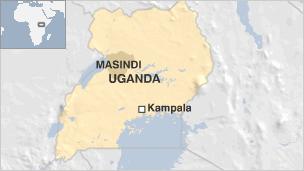Uganda lightning strike kills school children
- Published

Lightning has struck a junior school in western Uganda, killing 18 children and their teacher, officials say.
Police spokeswoman Judith Nabakooba told AFP news agency 15 girls and three boys had died at Runyanya Primary School in the Masindi area on Tuesday.
The local district commissioner told Uganda's Daily Monitor paper 36 pupils had been admitted to hospital.
Concern about the number of recent deadly lightning strikes has prompted MPs to raise the matter in parliament.
Up to 28 people have been killed by lightning and scores injured in the past week, the private Daily Monitor reports.
Uganda's Minister of State for Disaster Preparedness Musa Ecweru said the deaths occurred because buildings had not been installed with lightning rods.
"There are very many schools and brand new health centres which are lacking lightning arrestors," Mr Ecweru said.
He said it was "negligent" of construction engineers to certify the buildings as safe.
"I can assure you we are going to work with the relevant sectors to make sure that this is addressed.
"It is unfortunate that this is going to happen after we lost people," Mr Ecweru said.
Kiryandongo police commander Patrick Byaruhanga told Uganda's state-owned New Vision paper that the lightning struck at about 1630 local time (1330 GMT) as pupils were in their classrooms waiting for a downpour to subside before going home.
Ms Nabakooba said some of the more seriously injured pupils had been taken to Mulago Hospital in the capital, Kampala, more than 200km (125 miles) to the south-east.
A natural resource management specialist at Uganda's National Forestry Authority (UNFA), Marx Kabi, said the felling of trees was another major cause of lightning strikes.
"People have cut down trees, which used to absorb or provide a channel for the transmission of lightning. Most areas are now just covered with shrubs," he said.